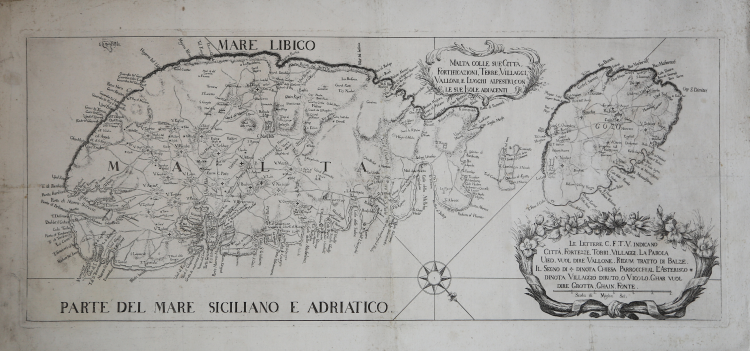




| Reference: | S39647 |
| Author | Giovanni Antonio CIANTAR |
| Year: | 1772 ca. |
| Zone: | Malta |
| Measures: | 725 x 305 mm |



| Reference: | S39647 |
| Author | Giovanni Antonio CIANTAR |
| Year: | 1772 ca. |
| Zone: | Malta |
| Measures: | 725 x 305 mm |
Beautiful and rare map of the Maltese archipelago printed in Malta in 1772-80.
The map is a derivation of the work contained in "Della descrittoone di Malta" by Giovanni Francesco Abela (1647). It belongs to the revision of Abela's book by Count Giovanni Antonio Ciantar "Malta Illustrata, Ovvero Descrizione Di Malta Con Le Sue Antichita', Ed Altre Notizie, Divisa in Quattro Libri, by Commendatore F. Giovanfrancesco Abela, corrected, increased and continued by Count Giovanniantonio Ciantar... ".
It was published in Malta in two volumes in folio, for a total of 1415 pages of text and about forty plates, in beautiful typographic form, for express will of the Grand Master of the Order, to whom it was dedicated. The first volume appeared in 1772, while the second one, due to the high printing costs, came out posthumously in 1780.
The fundamental work of Abela was thus corrected and updated by Ciantar, with numerous useful additions, always placed between quotation marks to distinguish them from the original text, which was also abundantly and intentionally modified in form to make it clearer and more fluent, according to the linguistic needs of the time. Moreover, the demanding determination to redo a work of Baroque historiography such as Abela's was certainly a response to the typically eighteenth-century rationalistic need to restore good taste, wisdom and usefulness.
Etching on copper, with margins, in perfect state of preservation. Rare.
|
MASON & WILLIS, Maps of Malta, n. 101
|
|
Count Giovanni Antonio Ciantar (1696-1778) has for long been regarded as the leading eighteenth century Maltese historian and letterato. Noted for his erudition and literary prolificity, Ciantar's permanent renown was, however, to rest to a very considerable extent on his Malta lIlustrata; a corrected and updated two volume edition of Giovanni Francesco Abela's Della Descrittione di Malta of 1647. This undoubtedly monumental undertaking, upon which Ciantar spent no less than sixteen years, certainly passed on to him the near-sacred aura which had surrounded Abela and his work since 1647. Abela-Ciantar was to remain, until quite recently, the undisputed master of the Maltese historiographical field, being quoted – and indeed plagiarized - extensively in many historical works. This synonimity of Ciantar with Malta iIIustrata though guaranteeing the fame of the author and, by comparison, dwarfing some of his contemporary Maltese letterati into insignificance was to result in the relative ignoring of Ciantar's all-round literary activity and, in particular, of his formative role within the Maltese eighteenth century cultural milieu. With the inevitable if overdue critical appraisal of Abela's Descrittione and the somewhat tarnishing of its image, Ciantar was similarly to recede in prominence, being obviously responsible for the invigoration of Abela's seventeenth century follies.
|
|
MASON & WILLIS, Maps of Malta, n. 101
|
|
Count Giovanni Antonio Ciantar (1696-1778) has for long been regarded as the leading eighteenth century Maltese historian and letterato. Noted for his erudition and literary prolificity, Ciantar's permanent renown was, however, to rest to a very considerable extent on his Malta lIlustrata; a corrected and updated two volume edition of Giovanni Francesco Abela's Della Descrittione di Malta of 1647. This undoubtedly monumental undertaking, upon which Ciantar spent no less than sixteen years, certainly passed on to him the near-sacred aura which had surrounded Abela and his work since 1647. Abela-Ciantar was to remain, until quite recently, the undisputed master of the Maltese historiographical field, being quoted – and indeed plagiarized - extensively in many historical works. This synonimity of Ciantar with Malta iIIustrata though guaranteeing the fame of the author and, by comparison, dwarfing some of his contemporary Maltese letterati into insignificance was to result in the relative ignoring of Ciantar's all-round literary activity and, in particular, of his formative role within the Maltese eighteenth century cultural milieu. With the inevitable if overdue critical appraisal of Abela's Descrittione and the somewhat tarnishing of its image, Ciantar was similarly to recede in prominence, being obviously responsible for the invigoration of Abela's seventeenth century follies.
|